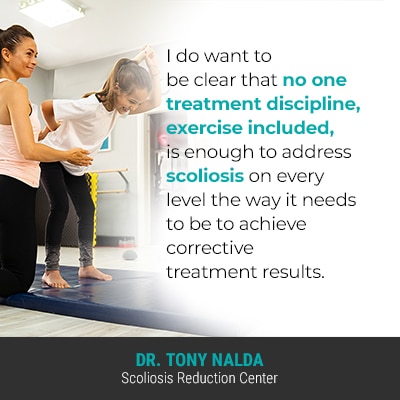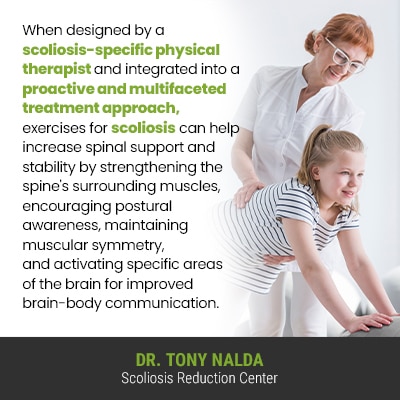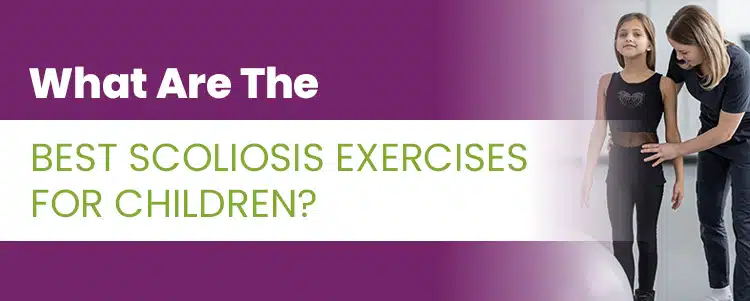When it comes to treating scoliosis in children, being proactive is key; as a progressive condition triggered by growth, children are the most at risk for rapid-phase progression, particularly adolescents going through puberty. A scoliosis-specific exercise regimen is an important facet of treatment; continue reading to learn more about the role of exercise in treatment.
The best exercises for children with scoliosis have corrective potential. Scoliosis-specific exercises can help counteract the condition’s progressive nature by improving posture, spinal strength, flexibility, mobility, and by keeping the spine’s surrounding muscles strong and supportive, thereby slowing down curve progression.
Before discussing the specifics of scoliosis exercises for children, let’s first talk generally about childhood scoliosis.
Understanding Childhood Scoliosis
Scoliosis is a complex spinal condition that involves the development of an unnatural sideways-bending and rotating spinal curve, and as a progressive condition, the nature of scoliosis is to get worse over time.
Recognizing scoliosis symptoms early can lead to more effective management and treatment of the condition.
Scoliosis ranges widely in severity from mild scoliosis to moderate and severe to very severe scoliosis, and this is also the condition’s progressive line; where a child’s scoliosis is at the time of diagnosis isn’t indicative of where it will stay.
There are also different types of scoliosis, determined by causation, and scoliosis affects all ages from babies to infants, juveniles to adolescents, and adults who have reached skeletal maturity and face natural age-related spinal degeneration.
The most common type of scoliosis to affect both children and adults is idiopathic scoliosis: not clearly associated with a single-known cause.
Idiopathic scoliosis accounts for approximately 80 percent of known diagnosed cases, and the remaining 20 percent are associated with known causes: neuromuscular scoliosis, congenital scoliosis, and degenerative scoliosis.
The most prevalent type of scoliosis overall is adolescent idiopathic scoliosis, diagnosed between the ages of 10 and 18, so this is the type of childhood scoliosis we’ll focus on.
While we don’t understand what causes the majority of scoliosis cases to develop initially, we do understand what triggers scoliosis to get worse, and that’s growth.
Adolescent Idiopathic Scoliosis
Adolescent idiopathic scoliosis patients are the most at risk for rapid-phase progression due to the unpredictable and rapid growth spurts associated with puberty.
There is no way of knowing exactly which cases of scoliosis will progress quickly and which won’t, but we do know that the more growth a patient has to go through, the more potential progression they’re faced with, and we also know that the more severe a condition, the more likely it is to continue progressing, and females are more likely to progress faster than males.
When it comes to diagnosing adolescent idiopathic scoliosis, while there are never treatment guarantees, with early detection and intervention, there are fewer limits to what can be achieved, but being proactive is important so the condition’s progressive nature can be counteracted.
In addition to adolescent idiopathic scoliosis, thoracic scoliosis is another type that can affect children, characterized by a curvature in the upper (thoracic) part of the spine.
The goal of treating adolescent idiopathic scoliosis is to reduce the scoliotic curve and hold the reduction despite the constant progressive trigger of growth.
Each case of scoliosis is unique, and condition severity is an important factor when it comes to how noticeable a condition’s effects are, but in general, the earliest telltale signs of scoliosis in children involve postural deviation.
Scoliosis introduces a lot of uneven forces to the spine, its surrounding muscles and nerves, and the entire body, and these uneven forces can affect the body in a number of ways: by disrupting the body’s natural symmetry, for example.
In many cases, the earliest signs of scoliosis are often uneven shoulders and hips, and additional changes can include:
- An uneven eye-line
- A head that seems uncentered over the torso
- Uneven shoulder blades
- The development of a rib cage arch
- Arms and legs that don’t hang evenly
In addition to the aforementioned postural changes, disruptions to balance, coordination, and gait are also common.
As adolescents are in, or are entering into, the stage of puberty, being proactive means applying a proactive treatment approach with corrective potential, and exercises for scoliosis are an important facet of a conservative scoliosis treatment approach.
Causes and Risk Factors in Children
Scoliosis in children can be influenced by a combination of genetic, environmental, and hormonal factors. While the exact cause of scoliosis is often unknown, several risk factors can increase the likelihood of developing the condition.
One of the primary risk factors is a family history of scoliosis. If a child has relatives with scoliosis, they are more likely to develop the condition themselves. Age is another significant factor; scoliosis is most commonly diagnosed in children between the ages of 10 and 15, a period marked by rapid growth spurts.
Sex also plays a role, with girls being more likely to develop scoliosis than boys. Additionally, certain genetic conditions, such as Marfan syndrome and Ehlers-Danlos syndrome, can increase the risk of scoliosis. Neuromuscular conditions like cerebral palsy and muscular dystrophy are also associated with a higher risk of developing scoliosis.
It’s essential to understand that while these risk factors can contribute to the development of scoliosis, they do not guarantee that a child will develop the condition. Each case of scoliosis is unique, and the interplay of various factors can differ from one child to another.
Importance of Exercise for Scoliosis
Exercise plays a crucial role in managing scoliosis in children. Regular physical activity can significantly impact the condition by improving spinal alignment and reducing the curvature of the spine. Strengthening the muscles that support the spine is vital for maintaining stability and preventing further progression of the spinal curve.
In addition to enhancing spinal strength, exercise improves flexibility and range of motion, which are essential for maintaining overall spinal health. Regular exercise can also help reduce pain and discomfort associated with scoliosis, making daily activities more manageable for children.
Moreover, exercise promotes good posture, which is crucial for minimizing the risk of complications related to scoliosis. By incorporating scoliosis-specific exercises into a child’s routine, parents can help their children develop healthy habits that support long-term spinal health and overall well-being.
Benefits of Exercise for Kids with Scoliosis
Exercise offers numerous benefits for children with scoliosis, making it an integral part of a comprehensive treatment plan. One of the primary advantages is improved flexibility and range of motion, which helps children move more freely and comfortably. Increased strength and endurance are also significant benefits, as they enhance the muscles’ ability to support the spine effectively.
Better posture is another critical benefit of regular exercise. By strengthening the core and back muscles, children can maintain proper spinal alignment, reducing the risk of complications and further progression of the spinal curve. Exercise also helps alleviate pain and discomfort, making it easier for children to engage in daily activities without limitations.
Beyond the physical benefits, exercise can positively impact a child’s self-esteem and confidence. Engaging in regular physical activity can help children develop a positive body image and improve their overall quality of life. By incorporating exercise into their routine, children with scoliosis can enjoy a healthier, more active lifestyle.
Guidelines for Safe Exercise
When exercising with scoliosis, it’s essential to follow safe exercise guidelines to avoid exacerbating the condition. Here are some tips to ensure a safe and effective exercise routine:
- Consult with a healthcare provider or physical therapist before starting any exercise program. They can provide personalized recommendations based on the severity of the condition.
- Choose exercises that are low-impact and gentle on the spine. Activities like swimming, walking, and specific scoliosis exercises are excellent options.
- Avoid exercises that cause pain or discomfort. If an exercise feels painful, it’s essential to stop and consult with a healthcare provider.
- Start slowly and gradually increase the intensity and duration of exercise. This approach helps the body adapt and reduces the risk of injury.
- Listen to your body and rest when needed. It’s crucial to pay attention to how the body feels and take breaks as necessary.
Working with a qualified physical therapist or healthcare provider can help develop a customized exercise plan that meets your child’s specific needs, ensuring a safe and effective approach to managing scoliosis.
Consulting a Healthcare Provider
Before starting any exercise program for scoliosis, it’s essential to consult with a healthcare provider. A healthcare provider can diagnose the severity of scoliosis and recommend appropriate exercises tailored to the child’s condition. They can also monitor progress and make necessary adjustments to the exercise routine to ensure optimal results.
A healthcare provider can provide guidance on safe exercise techniques and precautions, helping to prevent injury and exacerbation of the condition. They can also address any concerns or questions you may have, offering reassurance and support throughout the treatment process.
By working with a healthcare provider, you can develop a comprehensive treatment plan that includes exercise, physical therapy, and other interventions to manage scoliosis effectively. This collaborative approach ensures that your child receives the best possible care and support for their condition.
Exercises for Scoliosis as Part of Treatment

I do want to be clear that no one treatment discipline, exercise included, is enough to address scoliosis on every level the way it needs to be to achieve corrective treatment results.
As a complex 3-dimensional spinal condition, scoliosis has to be impacted on multiple levels; it’s rotational component has to be addressed, its underlying structural nature needs to be addressed, and the health and strength of the spine’s surrounding muscles has to be improved, along with postural awareness and improving brain-body communication.
It’s not just the spine that has to maintain its natural curves and alignment; it also relies on its surrounding muscles to provide it with essential support and stabilization, and this is where scoliosis-specific exercises as part of physical therapy come in.
Physical Therapy and Scoliosis-Specific Exercises
As scoliosis progresses, this means the size of the unnatural spinal curve is increasing, and this makes the spine increasingly rigid, making it less responsive to treatment, and harder for patients to perform key therapeutic exercises as part of treatment, hence the benefit of starting treatment before significant progression has already occurred.
Working towards corrective treatment results means the unnatural spinal curve is going to be corrected on a structural level, and this involves condition-specific chiropractic care that uses a number of techniques and manual adjustments to adjust the position of the curve’s most-tilted vertebrae at its apex back into alignment with the rest of the spine.
Chiropractic care impacts the condition’s underlying structural nature, while physical therapy and scoliosis exercises can help impact the condition on a muscular level.
When designed by a scoliosis-specific physical therapist and integrated into a proactive and multifaceted treatment approach, exercises for scoliosis can help increase spinal support and stability by strengthening the spine’s surrounding muscles, encouraging postural awareness, maintaining muscular symmetry, and activating specific areas of the brain for improved brain-body communication.
SEAS and the Schroth Method

It’s difficult to pinpoint the best exercises for scoliosis in children because each case is unique, and exercise recommendations address specific patient/condition factors that vary from patient to patient.
SEAS (scientific exercises approach to scoliosis treatment) and the Schroth method emphasize the importance of postural awareness, core stability, proper spinal alignment, and the benefit of rotational angular breathing.
SEAS is an individualized exercise program that uses functional exercises to help patients with self-correction by using reflexes to stimulate neuromotor function and postural improvement.
Exercises can involve stretching and moving in opposition to the unnatural spinal curve in an effort to hold the spine in a corrective position through mirror image retraining: self-correction.
Schroth exercises can help address rotation, elongate and stabilize the spine through combining breathing, strength training, and postural awareness.
Exercises that are commonly used in the treatment of childhood scoliosis include the pelvic tilt, the cat-camel, a double leg abdominal press, a single leg balance, and planking.
Pelvic tilts can help keep the pelvis and hips loose, flexible, and strong, so they can support the lumbar spine and lower body movement, while the cat-camel pose can help increase spinal mobility by stretching tight back muscles; a double leg abdominal press can help engage the core muscles to improve posture and core stability, while a single leg balance performed in front of a mirror can help improve balance, spinal alignment, and postural awareness.
Planking can be also helpful by increasing the strength of the entire body with specific benefits to core strength and stability.
Conclusion
I can’t state which specific exercises are best for children with scoliosis because the answer is case-specific, but there are a variety of scoliosis-specific exercises and stretches that are commonly used as part of a conservative scoliosis treatment approach. Incorporating these exercises into a child’s routine is essential for promoting spinal health and ensuring long-term well-being.
Here at the Scoliosis Reduction Center®, exercises are a big part of treatment, whether as part of SEAS, or the Schroth method, or simply as part of a scoliosis-specific physical therapy program, when combined with other forms of treatment such as chiropractic care, corrective bracing, and rehabilitation, they can help improve posture, neurological function, spinal strength, flexibility, mobility, alignment, and stability.
As the complex nature of scoliosis necessitates the full customization of effective treatment plans, muscle imbalances and weak stomach muscles can be improved with exercise, and even after treatment is completed, as an incurable progressive condition, scoliosis treatment is more about managing an ongoing condition than reaching a fixed cure, and exercises are an important part of maintaining a scoliosis-friendly lifestyle.
An unnatural spinal curvature of the spine should be taken seriously, particularly in children because as growth is the condition’s progressive trigger, young patients are at risk for continued progression and poor posture, and the more severe a condition gets, the more complex it is to treat, and the more difficult it is to reverse its effects.
If scoliosis is severe and/or is left untreated in children, increasing postural changes are common, and increasing condition effects can cause complications such as disruptions to lung function, respiratory issues, digestive issues, migraines, and more.
Most children who are diagnosed early and receive conservative treatment started early in the condition’s progressive line can be treated successfully without invasive spinal surgery.
When the right exercises are designed by a scoliosis physical therapist and specifically address key patient/condition variables, they can help increase spinal mobility, flexibility, alignment, core strength, core stability, and improve posture to facilitate corrective treatment results.




